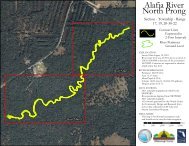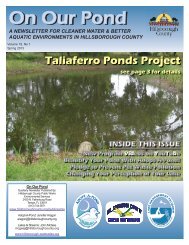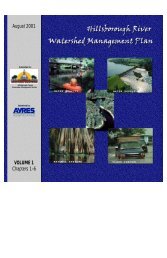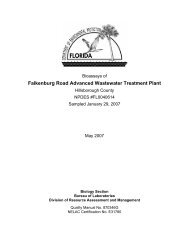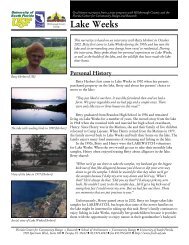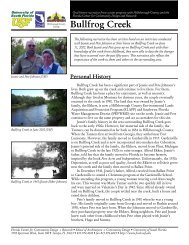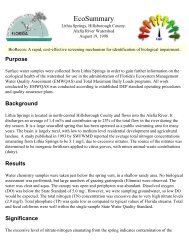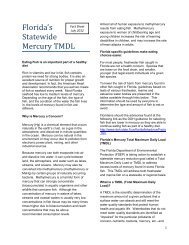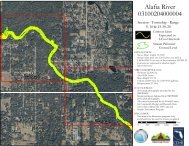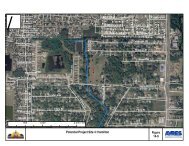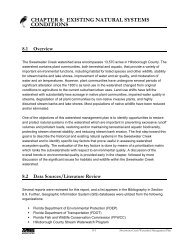Rocky Brushy Creek Watershed Mgmt. Plan (2007) -- Part 2
Rocky Brushy Creek Watershed Mgmt. Plan (2007) -- Part 2
Rocky Brushy Creek Watershed Mgmt. Plan (2007) -- Part 2
You also want an ePaper? Increase the reach of your titles
YUMPU automatically turns print PDFs into web optimized ePapers that Google loves.
EXISTING NATURAL SYSTEMS CONDITIONSCommunications (820)In the <strong>Rocky</strong> <strong>Creek</strong> - <strong>Brushy</strong> <strong>Creek</strong> watershed, this category includes microwave towers. It wasabsent in the 1950 mapping, and it occupied 0.07% of the watershed in 2004.Utilities (830)In the <strong>Rocky</strong> <strong>Creek</strong> - <strong>Brushy</strong> <strong>Creek</strong> watershed, this category includes: water treatment andtransmission facilities, and electrical transmission facilities. It was absent in the 1950 mapping, andit occupied 0.9% of the watershed in 2004. Utilities have existed in the watershed since the 1920’s.8.4.4 Natural Systems TrendsThis section identifies the historical and remaining upland, wetland, and aquatic natural systems inthe <strong>Rocky</strong>/<strong>Brushy</strong> <strong>Creek</strong> watershed and summarizes the relative loss of natural habitat between1950 and 2004 land cover. Existing land use classifications other than natural systems, such asreservoirs and developed and altered lands, were not included in the habitat loss analysis.Historical and existing land use types were consolidated into general habitats of uplands andwetlands for the purpose of estimating percent habitat loss. An exact analysis of "type for type"habitat loss is not possible due to differences in the classification of vegetation communities, aswell as inaccuracies inherent in the historical land use data.Table 8-4 demonstrates the historical and existing upland and wetland acreage, the relative habitatloss of each based on the total available area of the natural systems.Historical and Existing Land Cover ChangesThe areal coverage of native uplands in the <strong>Rocky</strong>/<strong>Brushy</strong> <strong>Creek</strong> watershed in the predevelopmentperiod as estimated from the 1916 Soil Survey of Hillsborough County wasapproximately 26,740 acres. The areal coverage of uplands in the <strong>Rocky</strong>/<strong>Brushy</strong> <strong>Creek</strong> watershedin 1950 is estimated at 19,351 acres, and existing uplands are estimated at 2,060 acres.The difference between these periods represents a 90% net loss as native upland communitieswere converted to agricultural and urban land uses and supporting infrastructure. The mostattractive areas for citrus production were lands occupied by the longleaf pine-xeric oakcommunity, while pine flatwoods were the primary upland community displaced for pasturecultivation and cattle production. Residential development and transportation facilities also arepreferentially located on lands supporting these two plant communities. Remaining uplandcommunities have been degraded by land use practices on adjacent agricultural and urban landsand/or by encroachment on the margins of uplands. Most uplands now are remnants of a oncelarger habitat.The areal coverage of historical wetlands was estimated at 11,065 acres, and the coverage bywetlands today (2004) is approximately 7,728 acres, which represents a net loss of native wetlandsof 30% between the 1950 and 2004. Remaining wetlands have been degraded by physicaldisturbances associated with agricultural practices, the construction of transportation facilities, andresidential development. Wetlands located within citrus groves generally have been rim-ditched to8-16<strong>Rocky</strong>/<strong>Brushy</strong> <strong>Creek</strong> <strong>Watershed</strong> Management <strong>Plan</strong>



